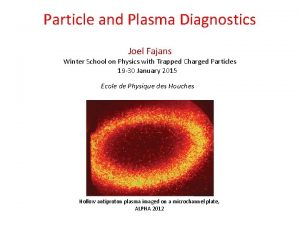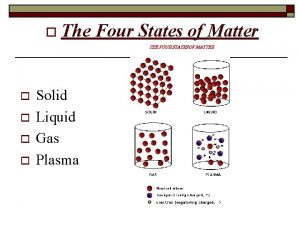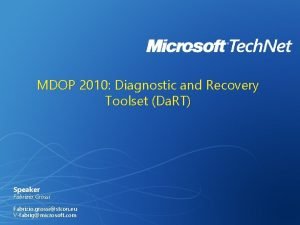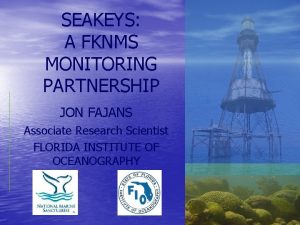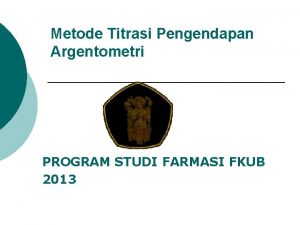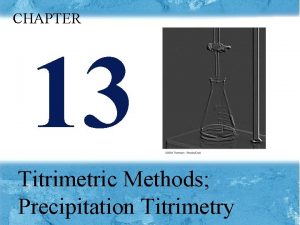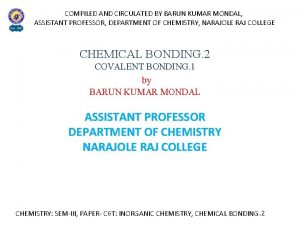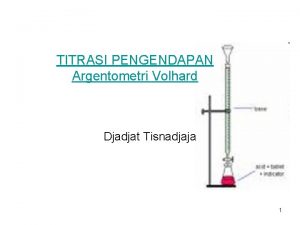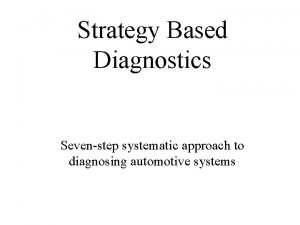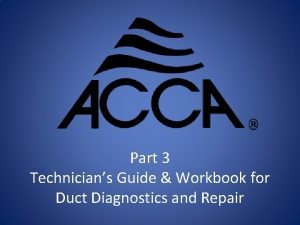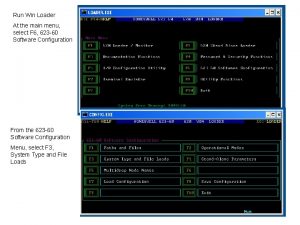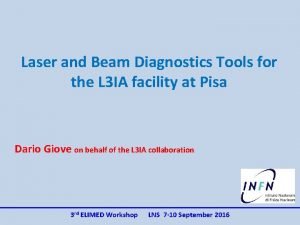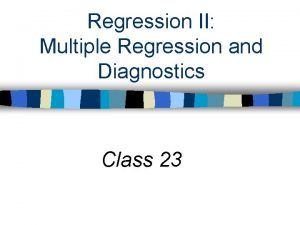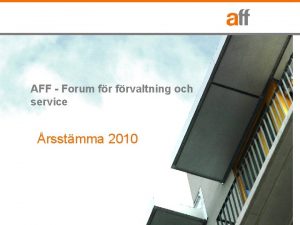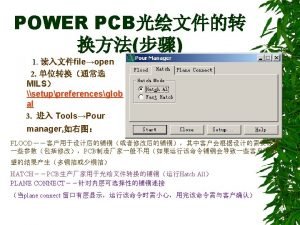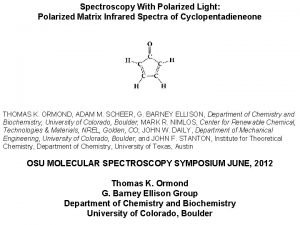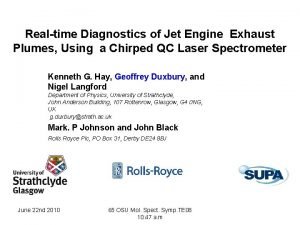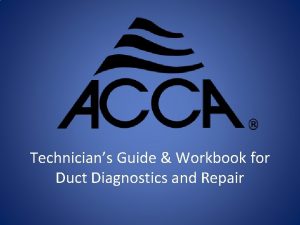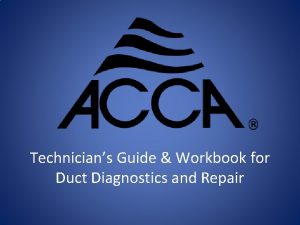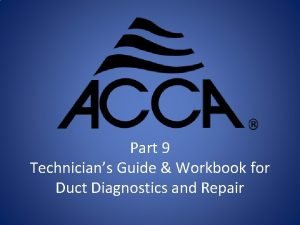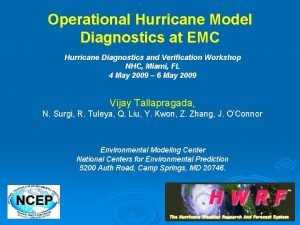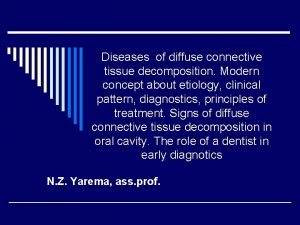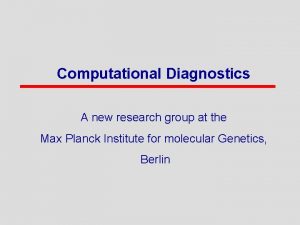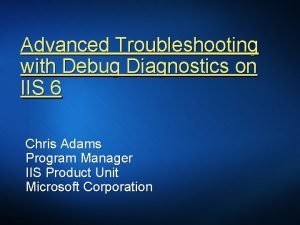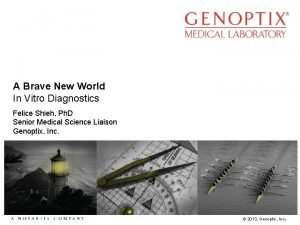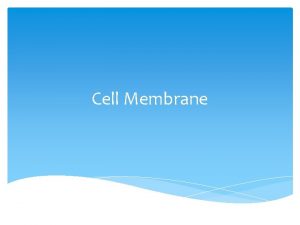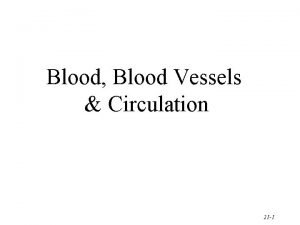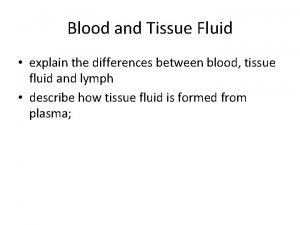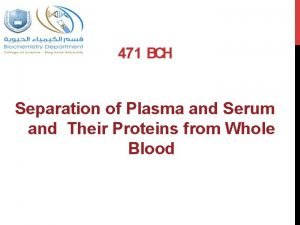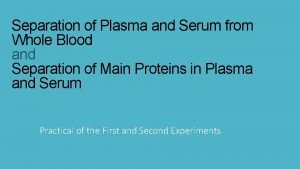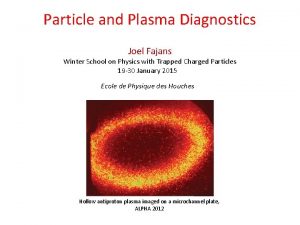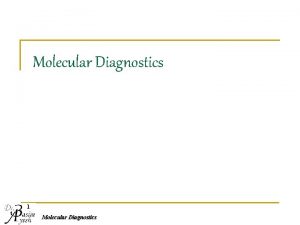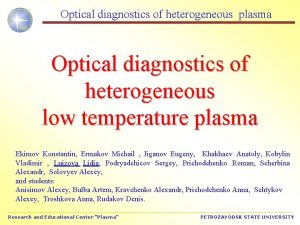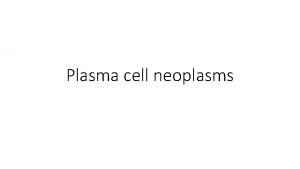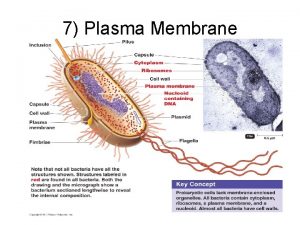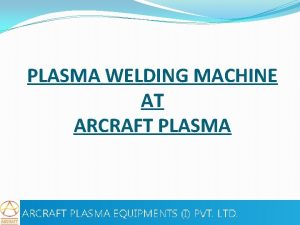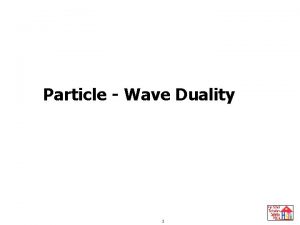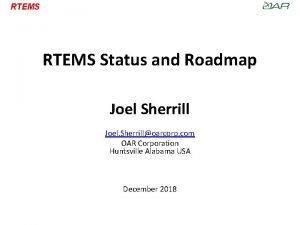Particle and Plasma Diagnostics Joel Fajans Winter School

































































- Slides: 65

Particle and Plasma Diagnostics Joel Fajans Winter School on Physics with Trapped Charged Particles 19 -30 January 2015 Ecole de Physique des Houches Hollow antiproton plasma imaged on a microchannel plate, ALPHA 2012

How Do You Make a Particle/Plasma Experiment Work? Surko-Style Positron Accumulator ALPHA-II Antihydrogen Apparatus BASE (Anti)Proton Magnetic Moment Apparatus

Interesting Parameters • Things we would like to know: • Particle Number. • Typical range: 103 to 109. • What type of particles are present? • Electrons, positrons, antiprotons, ions… T. B. Mitchell, J. J. Bollinger, D. H. E. Dubin, X. -P. Huang, W. M. Itano, R. H. Baughman, Science, 282 1290 (1998)

Interesting Parameters • Things we would like to know: • Particle Number. • Typical range: 103 to 109. • What type of particles are present? • Electrons, positrons, antiprotons, ions… • Radial Profile. • Typical range: 0. 2 mm to 10 cm. • Can the system be parameterized by a single number, i. e. the radius?

Interesting Parameters • Things we would like to know: • Particle Number. • Typical range: 103 to 109. • What type of particles are present? • Electrons, positrons, antiprotons, ions… • Radial Profile. • Typical range: 0. 2 mm to 10 cm. • Can system be parameterized by a single number, i. e. the radius? • Length. • Typical range: 0. 5 cm to 100 cm. • Density • Typical range: 103 to 109 cm-3. • Temperature • Typical range 10 to 107 K (0. 5 me. V to 1000 e. V). • Can system be parameterized by a single number, i. e. the temperature? A. W. Hyatt, C. F. Driscoll and J. H. Malmberg "Measurement of the Anisotropic Temperature Relaxation Rate in a Pure Electron Plasma, " Phys. Rev. Lett. 59, 2975 (1987)

Destructive vs. Nondestructive Diagnostics • Nondestructive: • Advantages • Can work with the plasmas afterwards. • Disadvantages • Can be slow. • Can leave a wave imposed on the plasmas. • Can heat the plasmas. • May be difficult to calibrate. • Destructive: • Advantages • Sometimes easier to calibrate. • Disadvantages • Destroys the plasmas. • Because the plasmas are changed radically, may have large systematic errors.

Non-Laser Based Diagnostics • Concentrate on particles/plasmas for which laser diagnostics don’t work. • Electrons, positrons, protons, antiprotons.

Particle Counting-Faraday Cups • Faraday cups are used to count charged particles. • Have been in use for a very long time. • Basic design is very simple. • Principal parts: • Charge collection cup: Self evident. • Grounded shield: Self evident • Secondary electron suppressor: • When the primary charged particle hit the cup, secondary electrons may be emitted • Secondary electron suppressor is biased negative relative to the charge collection cup. • Sends secondary electrons back to the cup.

Why are Faraday Cups Called Faraday Cups? Faraday’s Ice Pail (Effect first observed by Benjamin Franklin in 1755) http: //en. wikipedia. org/wiki/Faraday's_ice_pail_experiment http: //dev. physicslab. org/Document. aspx? doctype=3&filename=Electrostatics _Shells. Conductors. xml

Faraday Cup Implementation Complicated http: //en. wikipedia. org/wiki/Faraday_cup Simple

Faraday Cup Circuit Model Typical Circuit Response (ALPHA)

Faraday Cup Noise Circuit Model

Faraday Cup Noise Circuit Model For these parameters, thermal noise dominates.

Faraday Cup Noise Circuit Model • Actual Noise: about 200 k electrons. • Where does the noise come from? • 50/60 Hz coupling. • Noise pickup from nearby cables. • Accidental “thermocouple” junctions. • Bad solder joints. • Bad connectors. • Triboelectric effect. • System acts like a microphone. Typical Circuit Response (ALPHA)

Triboelectric Noise Test Weight is 40 times the weight of one foot of cable. Diagram of triboelectric noise test set-up specified in ANSI/AAMI 5. 5. 4 EC 53 All images from http: //www. affinitymed. com/news/2014/august. aspx

Radial Profile Diagnostic • Knowing the radius, and more generally the radial profile can be very helpful. • Can be used to compute the plasma density. This is critical for studies of waves, 3 -body recombination, calculating the collision frequency, etc. . • Can be used to check for and study instabilities. • Can be used to determine basic plasma shape. • Will tell you if the charge will fit through subsequent apertures. Increasing Octupole Field: ALPHA 2008 Berkeley

Radial Profile Hollow beam electron gun Phosphor Screen Kyhl, R. L. ; Webster, H. F. , Breakup of hollow cylindrical electron beams, IRE Trans. Electron Dev. , 3, 172 (1956).

Radial Profile Hollow antiproton plasma imaged on a microchannel plate, ALPHA 2012 A. J. Peurrung and J. Fajans, A pulsed, microchannel plate-based, non-neutral plasma imaging system. Rev Sci. Instrum. , 64: 52, 1993. G. B. Andresen, et al Antiproton, Positron, and Electron Imaging with a Microchannel Plate/Phosphor Detector, Rev. Sci. Inst. , 80, 123701, 2009.

Phosphor Screens http: //www. beamimaging. com/pscreen. html http: //www. proxivision. de/products/phosphor-screen. html

Phosphor Screen type composition emission P 43 Gd 2 O 2 S: Tb 540 nm green 1 ms P 46 Y 3 Al 5 O 12: Ce 530 nm green 300 ns P 47 Y 2 Si. O 5: Ce, Tb 400 nm blue 100 ns Type efficiency (lm/µA) decay efficiency (W/m. A) efficiency (ph/el) 6 k. V 10 k. V 12 k. V 15 k. V P 43 0, 24 0, 43 0, 54 0, 71 0, 43 0, 77 0, 97 1, 28 185 330 420 550 P 46 0, 08 0, 15 0, 19 0, 25 0, 22 0, 39 0, 49 0, 65 90 160 200 265 P 47 0, 06 0, 11 0, 14 0, 18 0, 62 1, 35 1, 71 2, 24 212 380 480 http: //www. proxivision. de/products/phosphor-screen. html • Detection Efficiency: • Phosphor Efficiency. • Detector (likely a CCD camera) efficiency. • Generally, slow phosphors are more efficient. http: //www. andor. com/learning-academy/ ccd-spectral-response-%28 qe%29 -defining-the-qe-of-a-ccd

Phosphor Screen Brightness No Al layer With Al Layer A. J. Peurrung and J. Fajans, A pulsed, microchannel plate-based, non-neutral plasma imaging system. Rev Sci. Instrum. , 64: 52, 1993. • Minimum voltage with a screen can be as low as about 1500 V. • Approximately 100 photons per electron is typical.

Microchannel Plates photonis. com http: //www. tectra. de/MCP. htm 1000 V http: //www. pe 1 hmm. nl/xx 1080/Introduction%20 to%20 Image%20 Intensifier%20 Tubes. htm Typical pore size 2 - 25µm

Microchannel Plate Gain http: //www. optimacorp. co. jp/Burle. EO/MCP. htm J. Wiza, Microchannel Plate Detectors, Nuclear Instruments and Methods, 162, 587 (1979).

What limits Microchannel Plate? • MCP starts to arc at high voltages. • Channel get exhausted. http: //www. pe 1 hmm. nl/xx 1080/Introduction%20 to %20 Image%20 Intensifier%20 Tubes. htm J. Wiza, Microchannel Plate Detectors, Nuclear Instruments and Methods, 162, 587 (1979).

Microchannel Plate Systems • MCP Front: Typically between -100 to +100 V. • MCP Back: Typically between 500 V to 1200 V. • Phosphor Screen: Typically 3000 -10000 V. Photonis APD Detector Brochure http: //www. dmphotonics. com/MCP_MCPImage. Intensifiers/microchannel_plates. htm Don’t do this yourself.

Microchannel Plate System Performance J. Wiza, Microchannel Plate Detectors, Nuclear Instruments and Methods, 162, 587 (1979). Coatings available to enhance detection efficiency For UV and X-rays.

Microchannel Plate System Performance J. Wiza, Microchannel Plate Detectors, Nuclear Instruments and Methods, 162, 587 (1979). Hollow antiproton plasma imaged on a microchannel plate, ALPHA 2012 ALPHA, Antiproton, Positron, and Electron Imaging with Microchannel Plate/Phosphor Detector, Rev. Sci. Inst. , 80, 123701, (2009).

Other Radial Diagnostics • The dream…. direct reading of charge onto a CCD-like chip. • Electronics would have to be UHV compatible. • No opportunity for service. • Detector area likely to be small. • Possibly complex electrical feedthrough issues. O. Hadjar, W. K. Fowler, G. Kibelka, W. C. Schnute, Preliminary demonstration of an Ion. CCD as an alternative pixelated anode for direct MCP readout in a compact MS-based detector, J. Am. Soc. Mass. Spectrom. , 23, 418, (2012).

Other Radial Diagnostics • Multiple ring Faraday cups and possibly expansion by magnetic field reduction. • Very crude. • Very slow if magnetic expansion is used. Plasma may change during expansion. • Usually requires many trials. B. R. Beck, J. Fajans and J. H Malmberg, Temperature and anisotropic-temperature relaxation measurements in cold, pureelectron plasmas. Phys. Plasmas, 3: 1250, 1996. B. R. Beck, Measurement of the magnetic and temperature dependence of the electron-electron anisotropic temperature relaxation rate. , Ph. D. Thesis, UCSD (1990).

Other Radial Diagnostics • Magnetic field lowering and antiproton annihilation. • Very crude. • Plasma may change during expansion. • Total Charge and Inner Line Density Faraday Cups • Requires the assumption of global thermal equilibrium. Berkeley Hollow antiproton plasma imaged on a microchannel plate, ALPHA 2012 G. Gabrielse et al, Centrifugal separation of antiprotons and electrons, Phys. Rev. Lett. , 105, 213002, (2010). P. Oxley et al, Aperture method to determine the density and geometry of anti-particle plasmas, Phys. Lett. B 595, 60 (2004). Berkeley

Density Reconstruction

Density Reconstruction

Density Reconstruction

Density Reconstruction

Density Reconstruction Waterbag example: a barely confined plasma.

Temperature Diagnostic • Consider a non-interacting, finite temperature, charged gas held in a potential well.

Temperature Diagnostic: Noninteracting Gas • Consider a noninteracting charged gas held in a potential well. How many gas particles escape?

Temperature Diagnostic: Noninteracting Gas • What is the slope on the log graph?

Temperature Diagnostic: Noninteracting Gas

Temperature Diagnostic: Noninteracting Gas

Temperature Diagnostic: Simple Complication • • • The wall potential is not the well potential: • The on-axis potential maximum is typically about 50% of the wall potential. • The exact ratio depends on the electrode radius to length radius. • The potential in the middle of the trap is not zero. Both these effect need to be accounted for in the voltage derivative. These issues are increasingly important in short traps.

Temperature Diagnostic: Modest Complication

Temperature Diagnostic: Modest Complication • Plasma expands during release. • 1 D adiabatic expansion: temperature declines to 41% of its original value in this example. • Plasma may undergo 3 D expansion: temperature declines to 74% of its original value in this example. • Actual expansion may be between 1 D and 3 D.

Temperature Diagnostic: Collective Effects • The self potential is largest on the axis.

Temperature Diagnostic: Radial Effects Well is deeper off-axis.

Temperature Diagnostic: Collective Effects The self potential is largest on the axis. Well is deeper off-axis. Both these effects lead to the plasma escaping on the axis first.

Temperature Diagnostic: From Where Does the Plasma Escape? Plasma End View

Temperature Diagnostic: Useful Charge Plasma End View D. L. Eggleston, C. F. Driscoll, B. R. Beck, A. W. Hyatt, and J. H. Malmberg, Parallel energy analyzer for pure electron plasma devices, Phys. Fluids B 4, 3432 (1992). B. R. Beck, Measurement of the magnetic and temperature dependence of the electron-electron anisotropic temperature relaxation rate, Ph. D Thesis, UCSD, 1990.

Temperature Diagnostic: Antiproton Temperatures Andresen et al (ALPHA Collaboration), Evaporative Cooling of Antiprotons to Cryogenic Temperatures, Phys. Rev. Lett. , 105 013003, 2010.

Temperature Diagnostic: Hot Lepton Temperatures

Temperature Diagnostic: Cold Lepton Temperatures

Temperature Diagnostic: Cold Temperatures and Noise • The straight line region is short, and somewhat arbitrary at low temperatures. • Pickup and amplifier noise limits the bottom end. • Roll over from self potential effects limits the top end. • To get into the tens of Kelvin region, one typically needs sensitivities on the order of hundreds to thousands of charges.

Temperature Diagnostic: Noise • The base temperature that one can measure is limited by amplifier and pickup noise. • Acoustic noise from triboelectric effects is in the same band as the electrical pickup. • This is particularly a problem in cyrogenic experiments. • Consider: • Mounting amps very close to the pickup. This may mean that the amps are: • In vacuum. • At cryogenic temperatures. • Alpha uses a MCP preamp very successfully. This is the same system as we use for our radial profiles.

Temperature Diagnostic: Cold Temperatures and Noise • Fitting a straight line seems arbitrary, but isn’t. • Fits are consistent to about 20%. • Systematic effects are on the order of 20% to 100%.

Multi Species Temperature Diagnostic ALPHA, Centrifugal Separation And Equilibration Dynamics In An Electron-Antiproton Plasma, Phys. Rev. Lett. 106, 145001 (2011) As the plasma cools, it separates. Good, qualitative diagnostic.

Beam Temperature Diagnostic: Pepperpot Beam emittance detector. http: //www. davidshure. com/ item/d 3111 b-silver-pepper-pots http: //www. dreebit. com http: //www. ischebeck. net/media/Beam%20 Profile%20 Images/slides/Pepper. Pot. html

Nondestructive Diagnostics • If you can’t use lasers, how can you talk to a plasma? • Use waves or modes. • Theory pioneered by Dan Dubin, and will be discussed by Francois. • Two modes particularly useful. • Sloshing mode: Used for calibration. • Breathing mode: Can be used to determine density, aspect ratio, temperature. M. D. Tinkle, R. G. Greaves, C. Surko, Lower order longitudinal modes of single-component plasmas. Phys. Plasmas, 2, 2880, (1995).

Modes Diagnostics • Put a plasma into a harmonic well. • Actually, doesn’t need to be too harmonic Which pickup is used for which mode?

Modes Diagnostics • Measure the frequencies of both modes. • Measure the total charge. • From these measurements, use somewhat nasty equations involving Legendre functions of the first and second kind to determine the aspect ratio, length and density of the plasma. M. D. Tinkle, R. G. Greaves, C. Surko, Lower order longitudinal modes of single-component plasmas. Phys. Plasmas, 2, 2880, (1995).

Modes Diagnostics • Closer look: • The theory predicts the mode frequency well, particularly for the second mode. (The first mode is used for calibration, and is defined to be exact. ) • The inverse prediction, which is what we want, is not particularly good. M. D. Tinkle, R. G. Greaves, C. Surko, Lower order longitudinal modes of single-component plasmas. Phys. Plasmas, 2, 2880, (1995).

Modes Diagnostics 1 Francis Robicheaux, personal communication. 2 Speck, Density and geometry of single component plasmas, Phys. Lett. B, 650, 119 (2007). M. D. Tinkle, R. G. Greaves, C. Surko, Lower order longitudinal modes of single-component plasmas. Phys. Plasmas, 2, 2880, (1995).

Modes Diagnostics • Why is the inverse prediction off? • The basic theory assumes the plasmas are cold. • The theory has been extended for warm plasmas. • This makes for a useful, relative, temperature diagnostic. M. D. Tinkle, R. G. Greaves, C. Surko, Lower order longitudinal modes of single-component plasmas. Phys. Plasmas, 2, 2880, (1995).

Modes Temperature Diagnostic ALPHA, In situ electromagnetic field diagnostics with an electron plasma in a Penning–Malmberg trap, New J. Phys. , 16, 013037 (2014).

Thermal Modes Diagnostics • Using nontrivial apparatus, thermal spectrum of the mode in the plasma can be measured. N. Shiga, F. Anderegg, D. H. E. Dubin, C. F. Driscoll and R. W. Gould , Thermally excited fluctuations as a pure electron plasma temperature diagnostic, Phys. Plasmas 13, 022109: , (2006).

Thermal Modes Diagnostics • Using nontrivial apparatus, thermal spectrum of the mode in the plasma can be measured. • From the power in the spectra, the temperature can be inferred. • This is the perfect nondestructive temperature diagnostic… • Except: • Calibration is difficult. • Probably requires a very quiet environment. • May require amplifiers whose noise temperature is lower than the temperature of the plasmas under measurement. N. Shiga, F. Anderegg, D. H. E. Dubin, C. F. Driscoll and R. W. Gould , Thermally excited fluctuations as a pure electron plasma temperature diagnostic, Phys. Plasmas 13, 022109: , (2006).
 Joel fajans
Joel fajans Plasma particles arrangement
Plasma particles arrangement Winter kommt winter kommt flocken fallen nieder
Winter kommt winter kommt flocken fallen nieder Es ist kalt es ist kalt flocken fallen nieder
Es ist kalt es ist kalt flocken fallen nieder Es ist kalt es ist kalt flocken fallen nieder
Es ist kalt es ist kalt flocken fallen nieder Da toolset
Da toolset Mitel 5000 hx
Mitel 5000 hx Koettsdorfer number
Koettsdorfer number лигограф
лигограф Fajan's rules
Fajan's rules Ndbc fowey
Ndbc fowey Fajan's rule
Fajan's rule Contoh indikator adsorpsi
Contoh indikator adsorpsi Preequivalence
Preequivalence Vowels exceptions
Vowels exceptions Fajan's rule
Fajan's rule Contoh soal argentometri metode mohr
Contoh soal argentometri metode mohr Is inorganic chemistry hard
Is inorganic chemistry hard Strategy based diagnostics
Strategy based diagnostics Duct diagnostics
Duct diagnostics Customer journey diagnostics
Customer journey diagnostics Loader diagnostics main menu
Loader diagnostics main menu Standard diagnostics inc
Standard diagnostics inc Laser beam diagnostics
Laser beam diagnostics Ergothérapeute questions d'entretien d'embauche
Ergothérapeute questions d'entretien d'embauche Birads score
Birads score Cole diagnostics jobs
Cole diagnostics jobs Casewise diagnostics
Casewise diagnostics Sensiring
Sensiring Ramsay scale
Ramsay scale Strongstep diagnostics
Strongstep diagnostics Aff definitioner
Aff definitioner Maximum number of diagnostics exceeded
Maximum number of diagnostics exceeded Molecular diagnostics
Molecular diagnostics Realtime diagnostics
Realtime diagnostics Free diagnostics service initiative
Free diagnostics service initiative Duct repair serpentine
Duct repair serpentine Duct diagnostics
Duct diagnostics Duct diagnostics
Duct diagnostics Emc diagnostics
Emc diagnostics Hiv diagnostics conference
Hiv diagnostics conference Kcf smart diagnostics
Kcf smart diagnostics Connective tissue
Connective tissue Computational diagnostics
Computational diagnostics Iis diagnostics
Iis diagnostics In vitro diagnostics
In vitro diagnostics School bus
School bus Mitoc winter school
Mitoc winter school Winter law school elsa
Winter law school elsa School crossing patrol winter coat
School crossing patrol winter coat Joel and zeus watch a soccer game
Joel and zeus watch a soccer game Joel feinberg the nature and value of rights
Joel feinberg the nature and value of rights Plasma and bose-einstein condensate
Plasma and bose-einstein condensate Plasma and bose-einstein condensate
Plasma and bose-einstein condensate Cell membrane location
Cell membrane location Difference between plasma and serum
Difference between plasma and serum Plasma and serum difference
Plasma and serum difference Blood vessels
Blood vessels Tissue hydrostatic pressure
Tissue hydrostatic pressure B lymphocytes and plasma cells
B lymphocytes and plasma cells B lymphocytes and plasma cells
B lymphocytes and plasma cells B lymphocytes and plasma cells
B lymphocytes and plasma cells Non functional plasma enzyme
Non functional plasma enzyme Functional and non functional plasma enzymes
Functional and non functional plasma enzymes Plasma and serum
Plasma and serum Serum vs plasma
Serum vs plasma
